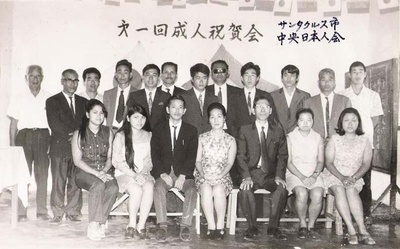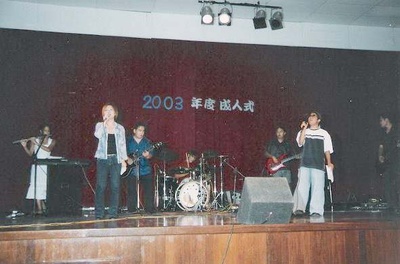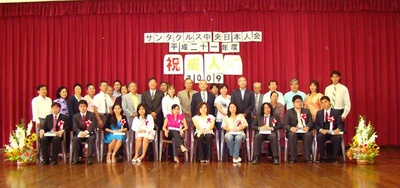One of the duties of Japanese and Nikkei groups is the bringing up of the younger generation. By carrying out the study of Japanese language and the passing on of culture during childhood, and teaching them in a natural way the system of social composition once they have become adults, these groups bring up the bearers of the future.
I also studied the Japanese language through the Japanese Association. When I reached adulthood, I went abroad for a period of time, then returned to Santa Cruz. Now I am engaged in group activities. I look at the generation of youth today and wonder at the fact that there was such a time for me too.
Thinking of the age of 21 as a boundary, I would like to reflect on the Coming of Age ceremony of the Santa Cruz Central Japanese Association, which has up to now fulfilled the role of guiding youth into the world of the adult.
For the Santa Cruz Central Japanese Association, the first Coming of Age ceremony that remains in the records was held in 1972. Since then, it has been held every year for 37 years as an established event.
In Japan, the school year begins in April, and who is to come of age is based by the school year; however, here the ceremony is held for those who turn 21 between January 1st and December 31st.
On average, every year 10 to 15 people take part in the Coming of Age ceremony with about an equal number of men and women. However, depending on the year, the number of people may be in the single digits or the difference between the numbers of men and women may be higher. In the early days, the attendance rate of those to come of age was 100%, but because as the years go on there are those who cannot attend due to reasons such as study abroad and work, in recent years about 80% have been attending.
It was customary for the Japanese Association’s Coming of Age ceremony to be held on the evening of the fifteenth of January, but, due to the combination of the schedules of the guests who go around both Okinawa and San Juan settlements in the same day, in recent years it has come to be held the morning of the Saturday or Sunday before or after the fifteenth. In addition, depending on the year, dances parties and the like are held through the Youth Association’s organization to welcome those who have newly come of age.
Depending on the ceremony, the president of the Japanese Association’s congratulatory address, presentation of a commemorative item, and commemorative photography are conducted with simplicity, accompanied by food and entertainment. The commemorative item varies according to year. In the early days, a Dictionary of Modern Practical Japanese was given. The author keeps this dictionary as a treasure to this day.
Today, the honorees of the early Coming of Age ceremonies lead the Japanese Association as its staff directors, while those who reached the ceremony in the 80s, including me, became the core generation. As the core generation, we realized the importance and continuation of the Santa Cruz Central Japanese Association and expressed our feeling to a new generation through the congratulatory address of the Coming of Age ceremony every year. The words below, which we present to the newly come of age, express this type of feeling:
“President Kennedy, upon taking office, spoke that he wanted his fellow Americans, before waiting for the country to do something for them, to think of what they can do for the good of their country. Borrowing these words, I would like for all those who have come of age to, before thinking of what Japanese/Nikkei society will give to you, from this point on think of what you can do and what you should do for the good of our society.”
© 2010 Takashi Aniya







